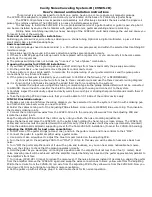Reviews:
No comments
Related manuals for vbBalancer

617
Brand: Keithley Pages: 55

9515
Brand: VELOCICALC Pages: 6

GF868
Brand: Panametrics Pages: 68

ElecTo Bulk
Brand: MADDALENA Pages: 4

M1 SERIES
Brand: Macnaught Pages: 4

FS300
Brand: R&S Pages: 248

UMG 96RM-P
Brand: janitza Pages: 128

CP67
Brand: Kawai Pages: 36

HI 84430
Brand: Hanna Instruments Pages: 25

HI 96762C
Brand: Hanna Instruments Pages: 28

GSM Mercury
Brand: Ocean Reef Pages: 24

SP0810
Brand: odoland Pages: 6

CMS-15
Brand: Eddy Wireless Pages: 18

Expert PDU energy 8001
Brand: Gude Pages: 22

CVNCS-JR
Brand: ILITCH ELECTRONICS Pages: 2

3 601 K76 710
Brand: Eaton Pages: 13

MJK MagFlux Series
Brand: Xylem Pages: 179

iMeter Master
Brand: jacarta Pages: 44

















